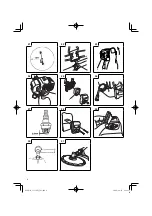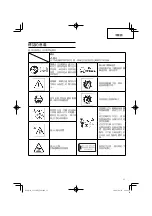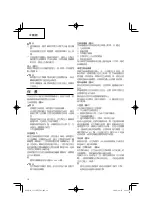
9
English
○
Never use multi-grade oil (10 W/30) or waste oil.
○
Always mix fuel and oil in a separate clean container.
Always start by
fi
lling half the amount of fuel, which is to be
used. Then add the whole amount of oil. Mix (shake) the
fuel mixture. Add the remaining amount of fuel.
Mix (shake) the fuel-mix thoroughly before
fi
lling the fuel
tank.
Fueling
WARNING
○
Always shut o
ff
the engine before refueling.
○
Slowly open the fuel tank, when
fi
lling up with fuel, so
that possible overpressure disappears.
○
Tighten the fuel cap carefully, after fueling.
○
Always move the Brush cutter at least 3 m (10 ft.) from
the fueling area before starting.
○
Always wash any spilled fuel from clothing immediately
with soap.
○
Be sure to check any fuel leaking after refueling.
Before fueling, clean the tank cap area carefully, to ensure
that no dirt falls into the tank. Make sure that the fuel is well
mixed by shaking the container, before fueling.
Starting
(
Fig.
15
)
CAUTION
Before starting, make sure the cutting attachment does
not touch anything.
1. Slide ignition switch (5) to RUN position. (
Fig.
15
)
Push priming bulb (6) several times so that fuel
fl
ows
through return pipe. (
Fig.
16
)
2. Set the throttle lever upward to the “idle” position (C).
(
Fig.
15
)
3. Set choke lever to “START” position. (
Fig.
17
)
4. Pull recoil starter briskly, taking care to keep the handle
in your grasp and not allowing it to snap back. (
Fig.
18
)
5. When you hear the engine want to start, return choke
lever to RUN position (open). Then pull recoil starter
briskly again.
NOTE
If engine does not start, repeat procedures from 2 to 5.
Cutting
(
Fig.
19,
20,
21
)
○
When cutting, operate engine at over 6500 rpm.
Extended time of use at low rpm may wear out the
clutch prematurely.
○
Cut grass from right to left.
○
Blade thrust may occur when the spinning blade
contacts a solid object in the critical area.
A dangerous reaction may occur causing the entire
unit and operator to be thrust violently. This reaction is
called BLADE THRUST. As a result, the operator may
lose control of the unit which may cause serious or
fatal injury. Blade thrust is more likely to occur in areas
where it is di
ffi
cult to see the material to be cut.
○
Wear the harness as shown in the
fi
gure. The blade
turns counter-clockwise, therefore, be advised to
operate the unit from right to left for e
ffi
cient cutting.
Keep onlookers out of working area at least 15 m (50
ft.).
How
to
use
the
shoulder
harness
Wear the shoulder harness on your shoulder as shown
Fig.
20
and hook it on the hanger of the machine. Adjust
the length of the shoulder harness to the most comfortable
position. (
Fig.
20
)
To remove the machine from the shoulder harness, hold
the main pipe of the machine
fi
rmly by one hand and then
remove the hook (7) of the shoulder harness from the
hunger (8). (
Fig.
22
)
WARNING
○
When using the machine, wear the shoulder harness
and hold the machine correctly with both hands.
If you feel that there is something dangerous, separate
the brush cutter from your body.
○
If cutting attachment should strike against stones or
other debris, stop the engine and make sure that the
attachment and related parts are undamaged. When
grass or vines wrap around attachment, stop engine
and attachment.
Stopping
(
Fig.
23
)
Decrease engine speed and run at an idle for a few minutes,
then turn o
ff
ignition switch (5).
WARNING
A cutting attachment can injure while it continues to
spin after the engine is stopped or power control is
released. When the unit is turned o
ff
, make sure the
cutting attachment has stopped before the unit is set
down.
MAINTENANCE
MAINTENANCE, REPLACEMENT OR REPAIR OF THE
EMISSION CONTROL DEVICES AND SYSTEMS MAY
BE PERFORMED BY ANY NON-ROAD ENGINE REPAIR
ESTABLISHMENT OR INDIVIDUAL.
Carburetor adjustment (
Fig.
24
)
WARNING
The cutting attachment may be spinning during
carburetor adjustments.
Never start the engine without the complete clutch
cover and tube assembled! Otherwise the clutch can
come loose and cause personal injuries.
In the carburetor, fuel is mixed with air. When the engine
is test run at the factory, the carburetor is basically
adjusted. A further adjustment may be required,
according to climate and altitude. The carburetor has
one adjustment possibility:
T = Idle speed adjustment screw.
Idle
speed
adjustment
(
T
)
Check that the air
fi
lter is clean. When the idle speed is
correct, the cutting attachment will not rotate. If adjustment
is required, close (clockwise) the T-screw, with the engine
running, until the cutting attachment starts to rotate. Open
(counter-clockwise) the screw until the cutting attachment
stops. You have reached the correct idle speed when the
engine runs smoothly in all positions well below the rpm
when the cutting attachment starts to rotate.
If the cutting attachment still rotates after idle speed
adjustment, contact a HITACHI dealer.
NOTE
Standard Idle rpm is 2200 – 2800 rpm.
WARNING
When the engine is idling the cutting attachment must
under no circumstances rotate.
Air
fi
lter
(
Fig.
25
)
The air
fi
lter must be cleaned from dust and dirt in order
to avoid:
○
Carburetor malfunctions.
○
Starting problems.
○
Engine power reduction.
○
Unnecessary wear on the engine parts.
○
Abnormal fuel consumption.
Clean the air
fi
lter daily or more often if working in
exceptionally dusty areas.
000Book̲CG31EBS̲Tha.indb 9
000Book̲CG31EBS̲Tha.indb 9
2009/06/30 16:29:12
2009/06/30 16:29:12
























